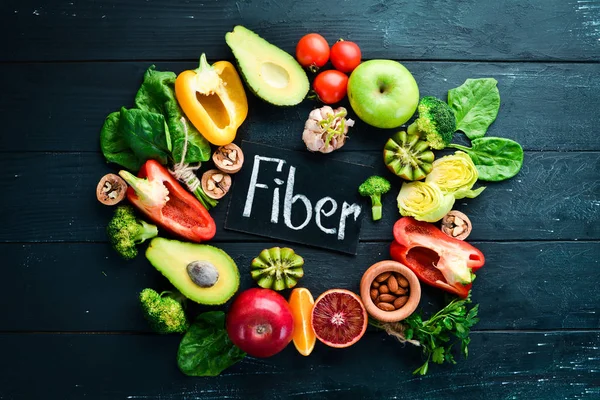High-fiber foods chart for constipation is crucial for those seeking relief and improved gut health. Dietary fiber, an indigestible component of plant foods, plays a pivotal role in maintaining the health of the digestive system. Common digestive issues such as constipation can be alleviated through a diet rich in fiber. This introduction sets the stage for a deeper exploration into the types of fiber, their benefits, and how to effectively integrate high-fiber foods into your diet.
Table of Contents
ToggleFiber: What You Need to Know
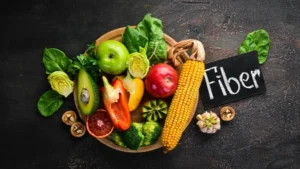
Fiber is classified into two main types, each playing a distinct role in digestive health:
- Soluble Fiber: This type of fiber dissolves in water to form a gel-like substance in the gut. It helps to slow down digestion, which can regulate blood sugar and lower cholesterol. Common sources include oats, apples, and beans.
- Insoluble Fiber: Unlike its counterpart, insoluble fiber does not dissolve in water. It adds bulk to the stool and helps food pass more quickly through the stomach and intestines, which is beneficial for those suffering from constipation. Foods rich in insoluble fiber include wheat bran, vegetables, and whole grains.
Incorporating a balanced mix of these fibers is key to the effectiveness of a high-fiber foods chart for constipation, as it ensures both types of fiber are consumed for optimal health benefits.
Health Benefits of Fiber
Fiber offers extensive health benefits that go beyond easing constipation. Here’s how regular fiber intake can impact your health positively:
- Heart Health: Soluble fiber helps to reduce cholesterol levels, which can decrease the risk of heart disease.
- Blood Sugar Control: By slowing the absorption of sugar, fiber helps to control blood sugar levels, making it beneficial for diabetes management.
- Weight Management: High-fiber foods are more filling, which helps control appetite and may aid in weight loss.
- Digestive Health: Regular fiber intake helps to normalize bowel movements and decrease the chances of constipation, hemorrhoids, and diverticulitis.
Eating a variety of fiber-rich foods is essential to harness these health benefits, making a high-fiber foods chart for constipation an invaluable tool for dietary planning.
High-Fiber Foods Chart for Constipation
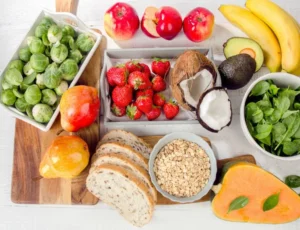
To help you easily incorporate high-fiber foods into your diet, here’s a detailed high-fiber foods chart for constipation. This chart categorizes foods based on their fiber content, providing a convenient reference for meal planning:
Fruits
- Apples (with skin): 4.4 grams per medium fruit
- Bananas: 3.1 grams per medium fruit
- Oranges: 3.1 grams per medium fruit
- Raspberries: 8 grams per cup
- Pears (with skin): 5.5 grams per medium fruit
Vegetables
- Carrots: 3.6 grams per medium carrot
- Broccoli: 2.4 grams per cup
- Artichokes: 10.3 grams per medium artichoke
- Green peas: 7.2 grams per cup
- Spinach: 4.3 grams per cup, cooked
Grains
- Whole Wheat Pasta: 6.3 grams per cup, cooked
- Barley: 6 grams per cup, cooked
- Bran Flakes: 5.5 grams per cup
- Oatmeal: 4 grams per cup, cooked
- Quinoa: 5.2 grams per cup, cooked
Legumes
- Lentils: 15.6 grams per cup, cooked
- Black Beans: 15 grams per cup, cooked
- Chickpeas: 12.5 grams per cup, cooked
- Split Peas: 16.3 grams per cup, cooked
- Kidney Beans: 13.6 grams per cup, cooked
This high-fiber foods chart for constipation offers a variety of options to boost your fiber intake, supporting not only digestive health but overall well-being.
Dietary Recommendations and Guidelines
To effectively manage and prevent constipation, understanding the recommended daily intake of fiber is essential. Here are the general fiber intake recommendations according to age and gender:
- Adult Men under 50: 38 grams per day
- Adult Women under 50: 25 grams per day
- Men over 50: 30 grams per day
- Women over 50: 21 grams per day
For those specifically using a high-fiber foods chart for constipation, aiming for the higher end of these recommendations can be particularly beneficial. Gradual increases in fiber intake are advised to allow the digestive system to adjust without discomfort. Here are some tips to help increase fiber intake effectively:
- Start Small: Increase fiber gradually over several weeks to avoid digestive distress like bloating and gas.
- Mix It Up: Include a variety of fiber sources from fruits, vegetables, grains, and legumes to cover both soluble and insoluble fibers.
- Stay Hydrated: Drinking plenty of water is crucial as fiber works best when it absorbs fluid, helping to soften stools and promote regular bowel movements.
By following these guidelines, you can maximize the benefits of the high-fiber foods chart for constipation and improve your overall digestive health.
Sample High-Fiber Diet Plans
To help you incorporate high-fiber foods into your daily meals effectively, here are sample meal plans using the high-fiber foods chart for constipation:
Breakfast Options
- Oatmeal with Fresh Berries and Flaxseeds: 1 cup of cooked oatmeal (4 grams of fiber) topped with ½ cup of raspberries (4 grams) and 1 tablespoon of ground flaxseeds (2 grams).
- Whole Wheat Toast with Avocado: 2 slices of whole wheat bread (4 grams of fiber each) topped with ½ mashed avocado (5 grams).
Lunch Options
- Vegetable and Bean Soup: A hearty bowl of soup made with kidney beans (13.6 grams per cup), chopped carrots, celery, and tomatoes.
- Quinoa Salad: 1 cup of cooked quinoa (5.2 grams) mixed with chopped spinach, cherry tomatoes, and cucumber, dressed with olive oil and lemon juice.
Dinner Options
- Grilled Vegetable and Chickpea Stir-Fry: 1 cup of chickpeas (12.5 grams) stir-fried with assorted vegetables like broccoli, bell peppers, and zucchini.
- Lentil Pasta with Marinara Sauce: 1 cup of cooked lentil pasta (approximately 13 grams of fiber) topped with homemade marinara sauce and fresh basil.
Snacks
- Almonds: A small handful of almonds (about 23 nuts) provides 3.5 grams of fiber.
- Apple with Peanut Butter: 1 medium apple with skin (4.4 grams) with 1 tablespoon of natural peanut butter (1 gram).
These meals showcase how the high-fiber foods chart for constipation can be used to create balanced, fiber-rich meals throughout the day.
Practical Tips for Increasing Fiber Intake
Increasing the amount of fiber in your diet doesn’t have to be difficult. Here are practical tips to help you effectively use the high-fiber foods chart for constipation and increase your fiber intake:
Tips for Incorporating More Fiber:
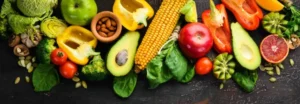
- Choose Whole Fruits over Juice: Opt for whole fruits instead of juice to gain the full benefits of the fiber content.
- Switch to Whole Grains: Replace white rice, bread, and pasta with whole-grain alternatives.
- Snack on Vegetables: Keep raw vegetables like carrots, bell peppers, and broccoli handy for easy snacking.
- Add Legumes to Meals: Include beans, lentils, or chickpeas in salads, soups, and stews to boost fiber content.
- Start Your Day with Fiber: Begin with a high-fiber breakfast such as a bowl of bran cereal or whole oats.
How to Adjust to Increased Fiber Intake:
- Increase Gradually: Start with adding just one high-fiber food per day and gradually increase as your digestive system adjusts.
- Monitor Your Body’s Response: Pay attention to how your body reacts to increased fiber and adjust your intake accordingly.
- Combine Fiber with Plenty of Fluids: To help manage the increase in fiber and prevent bloating or constipation, drink adequate amounts of water.
These actionable tips can help you maximize the health benefits of the high-fiber foods chart for constipation, enhancing both digestive health and overall wellness.
Supplements and Additional Dietary Considerations
While a diet rich in natural sources of fiber is most beneficial, supplements can be useful in certain situations. Here’s how to consider supplements alongside the high-fiber foods chart for constipation:
When to Consider Fiber Supplements:
- For Immediate Relief: When quick constipation relief is needed, a fiber supplement may be helpful.
- Dietary Restrictions: If dietary restrictions prevent adequate fiber intake, supplements can help fill the gap.
Choosing the Right Fiber Supplements:
- Types of Fiber Supplements: Look for supplements that contain natural fibers like psyllium husk, which is effective and gentle on the stomach.
- Check for Additives: Choose supplements without artificial additives and sweeteners to avoid unnecessary chemicals in your diet.
Additional Dietary Tips:
- Incorporate Prebiotics and Probiotics: These enhance the effectiveness of dietary fiber and support gut health.
- Balanced Diet: Ensure your diet is balanced with adequate protein, healthy fats, and carbohydrates to support overall health.
Utilizing fiber supplements wisely and maintaining a balanced diet are crucial steps to complement the benefits provided by the high-fiber foods chart for constipation.
Lifestyle Adjustments to Complement High-Fiber Diet
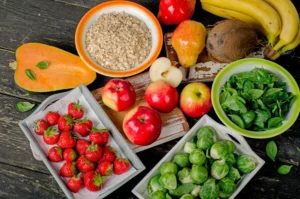
Adopting lifestyle changes that support a high-fiber diet can enhance digestive health and overall wellness. Here are some key adjustments to consider along with following the high-fiber foods chart for constipation:
Key Lifestyle Changes:
- Regular Physical Activity: Engage in regular exercise, which can help stimulate intestinal function and improve bowel movements.
- Adequate Hydration: Drinking sufficient water daily is crucial, especially when increasing fiber intake, as it helps fiber function effectively in the digestive system.
- Stress Management: Reducing stress through activities like yoga, meditation, or regular relaxation can positively impact your digestive health.
Implementing Changes:
- Set Realistic Goals: Start with small, manageable goals for exercise and gradually increase the intensity and duration.
- Make Water Accessible: Keep a water bottle handy at all times to ensure you stay hydrated throughout the day.
- Routine Schedule: Try to eat at regular times each day to help regulate your digestive system.
By integrating these lifestyle adjustments, you can maximize the benefits of the high-fiber foods chart for constipation and lead a healthier life.
Read Also:
-
A Comprehensive Guide to Supplements for Digestive Health – Nurturing Digestive Wellness
-
Understanding When to Worry: What Size of Ovarian Cyst is Dangerous?
-
8 Incredible Chia Seeds Benefits for Skin: Why Your Dermatologist Might Recommend Them
-
5 Proven Benefits: How Vitamin B6 and Unisom Ease Morning Sickness Safely
